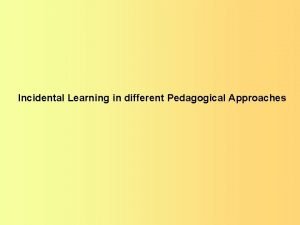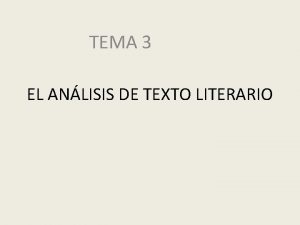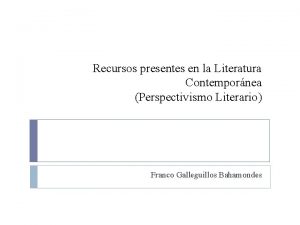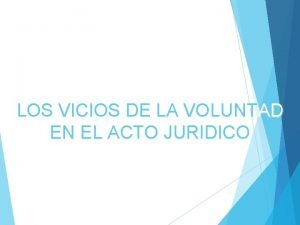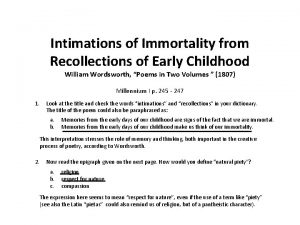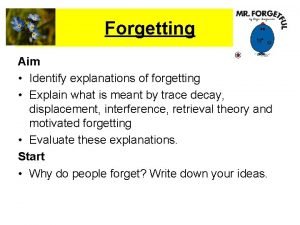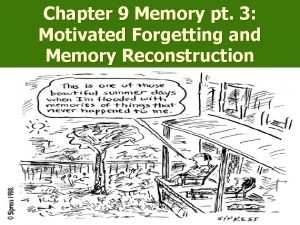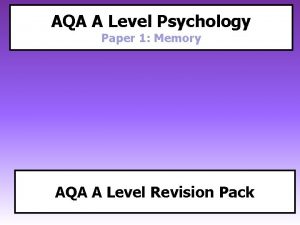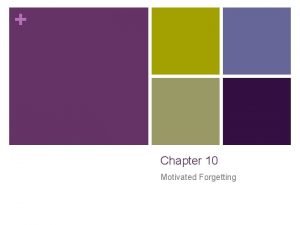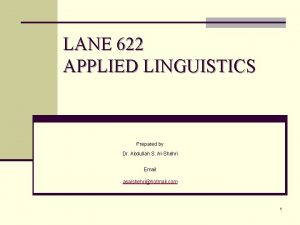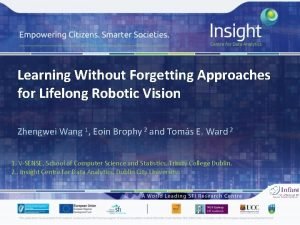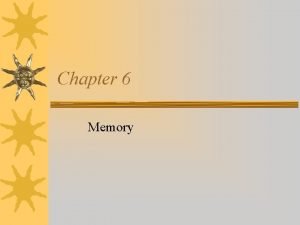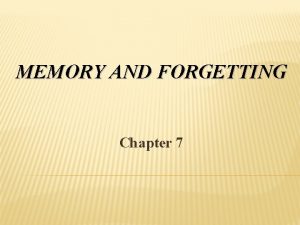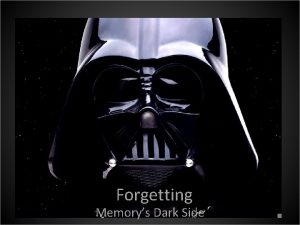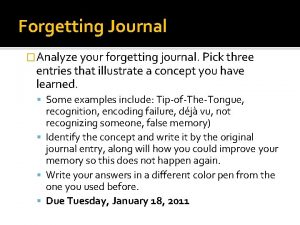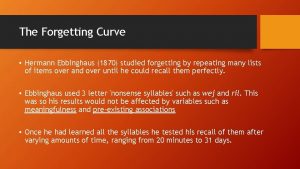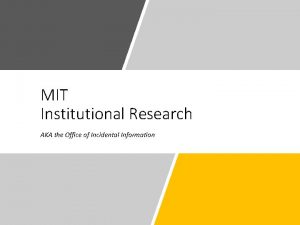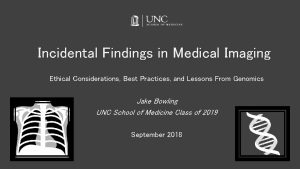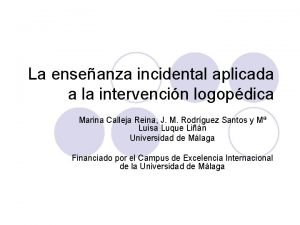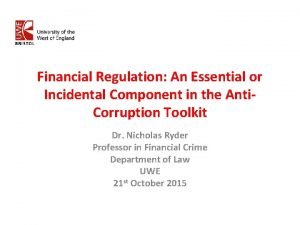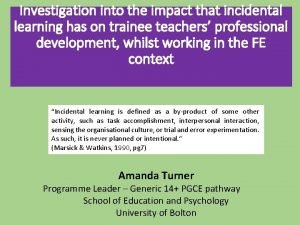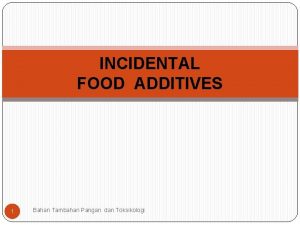Chapter 9 Incidental Forgetting 2 Forgetting Incidental Forgetting






























- Slides: 30

+ Chapter 9 Incidental Forgetting

+ 2 Forgetting Incidental Forgetting n Occurs without the intention to forget. Motivated Forgetting n Occurs when people purposefully engage in processes/behaviors that intentionally diminish a memory’s accessibility.

+ 60 Minutes Show on Superior Autobiographical Memory n http: //www. cbsnews. com/video/watch/? id=7166313 n&tag=content. Main; content. Body

+ 4 Hyperthymestic Syndrome n n Hyperthymestic Syndrome: n Uncontrollable remembering n Like the person on the TV show “Unforgettable” Parker, Cahill, and Mc. Gaugh’s (2006) case study of AJ: n 41 years old n Remembers every day of her life, in detail, since her teens. n Feels as though she relives the events she remembers. n Remembering feels “automatic” and not under conscious control. n Can verify events with the diary she keeps. n AJ’s superior memory has costs: n She cannot forget unpleasant memories. n Constant reminders are distracting and sometimes troubling.

+ 5 Ebbinghaus’s (1913) Forgetting Curve n Forgetting increases as time progresses – the rate of forgetting changes n Ebbinghaus (1913) studied memory for nonsense syllables and plotted: n A retention curve n n A roughly linear relationship between time and retention A forgetting curve n A logarithmic relationship between time and forgetting n A rapid rate of forgetting initially n Less additional forgetting at longer delays Data from Ebbinghaus (1913).

+ 6 Forgetting Personal Memories Meeter, Murre, and Janssen (2005) n They aimed to determine the forgetting rate for people’s memory of widely publicized events from headlines and TV broadcasts, obtained from verifiable sources. n Task: n n 14, 000 participants completed an internet questionnaire, assessing recall and recognition for 1, 000 dateable events. Results: n Like the Ebbinghaus results, recall for events shows a steep initial drop, followed by a slower forgetting rate. n Participants’ memory was worse for recall than for recognition of the same events. n Recall for events dropped from 60% to 30% in a year, then stayed constant. n After several years, 31% recall but 52% recognition.

+ 7 Forgetting Classmates Bahrick, and Wittlinger (1975) n Tested nearly 400 high-school graduates on their ability to recognize and name classmates after delays of up to 30 years. n n Results were mixed: n Relatively unimpaired : n Ability to recognize their classmates’ faces/names. n Ability to match up names to the appropriate portraits. n Extensively impaired: n Ability to recall a name, given a person’s portrait. Conclusion: n Recall, but not recognition, of well-learned personal material, closely follows the forgetting curve first demonstrated by Ebbinghaus (1913).

+ 8 Permastore Bahrick (1984) n Permastore: n n n An analogy to permanently frozen Polar regions. Describes the leveling off of the forgetting curve at long delays. n Beyond this point, memories appear impervious to further forgetting. PERMASTORE Bahrick (1984) n n Forgetting of a foreign language asymptotes (levels off) after about 2 years. The overall level of retention is determined by the level of initial learning. Data from Bahrick (1984).

+ 9 The Nature of Forgetting n Generally, more is recognized than can be recalled; therefore, a distinction should be drawn between a memory’s: n n n It is difficult to prove definitively that a memory is truly unavailable. n n n Availability: n Whether or not an item is in the memory store. Accessibility: n Whether the memory can be retrieved, assuming that it is stored. It could simply be temporarily inaccessible because it lacks an appropriate cue. Forgetting is not all or nothing but occurs gradually (in a graded fashion). Because we cannot differentiate between unavailable and inaccessible memories they are both said to be forgotten.

+ 10 Factors that Discourage Forgetting n Better initial learning leads to better retention. n Repeated retrieval attempts (i. e. testing) builds up resistance to forgetting (Linton, 1975). n This works at least for those aspects of the memory that are practiced. n Incomplete or inaccurate retrieval (e. g. , containing reconstructive inferences) may lead to memory distortions. n Jost’s Law: n All else equal, older memories are more durable and forgotten less rapidly than newer memories. n It is now widely believed that new traces are initially vulnerable to disruption until they are consolidated into memory.

+ 11 Repeated Testing is Protective The probability of remembering something depends on the number of times it has been retrieved or called to mind. Recalling an event reduces the rate of forgetting. Data from Linton (1975).

+ 12 Types of Consolidation n Consolidation: The time-dependent process by which new memory traces are gradually cemented and interconnected in memory. Synaptic Consolidation n n Structural changes in the synaptic connections between neurons. n Relies on biological processes n n Systemic Consolidation The gradual shift of a memory’s reliance away from the hippocampus and to the cortex. n Accomplished by repeatedly “replaying” a memory’s various components until they are interlinked. n May take years to complete in humans. May take hours to days to complete. Memories remain vulnerable until these changes occur. n Memories are vulnerable until they become independent of the hippocampus.

+ 13 Causes of Incidental Forgetting n n Trace decay – due to the passage of time. n Applies to working memory and priming effects (activation levels). n Hard to demonstrate empirically. Context shifts – this results in different cues being available and the ones present during encoding being absent. n n This is especially likely as an explanation for infantile amnesia (forgetting of early childhood). Interference – storing similar memories impedes retrieval. n Over time, many similar experiences occur, especially since people are creatures of habit.

+ 14 Factors that Encourage Incidental Forgetting n Trace Decay: n n The gradual weakening of memories resulting from the mere passage of time. n Commonly thought to partially determine the rate of forgetting for verbal and visual working memory. n Repetition priming and familiarity are considered especially vulnerable to trace decay. Either: n A memory’s activation may fade, but the underlying memory is left intact (i. e. stored/available). n The memory’s structural elements (i. e. its associations) degrade along with its activity level.

+ 15 Factors that Encourage Incidental Forgetting n A biological basis of decay: n n Neurons die and synaptic connections degrade over time, along with the associated learned behavior. Trace decay is difficult to prove behaviorally because: n n It is necessary to rule out alternative sources of forgetting, including: n Rehearsal n Interference from any new experiences/memories. It is typically impossible to show whether the memories are unavailable or just inaccessible.

Factors that Encourage Incidental + Forgetting Correlates of Time n Even if the passage of time (decay) isn’t the direct cause of forgetting, a correlate of time may, instead, be responsible. Contextual Fluctuation n n Mismatches between the retrieval and encoding contexts encourage forgetting. n Incidental context (internal and external) shifts over time. n Thus, the current incidental context is most similar to recent events. May explain infantile amnesia n Infant perspective and linguistic abilities differ considerably from an adult’s. Interference n It is difficult to discriminate between similar memories. n The number of similar experiences/memory traces accumulates over time. n Interference arises whenever the cue that is used to access a target becomes associated with other memories. n e. g. it is difficult generating the verb meaning of “DUCK” because the noun meaning is so dominant. 16

Factors that Encourage Incidental + Forgetting 17 Interference n Competition Assumption (Anderson, Bjork, & Bjork, 1994): n n n A cue activates all of its associates to some degree. The activated associates compete for access to awareness. n Competitors are any associates other than the target memory. Interference: n Any negative effect on memory arising from having competitors. n Increases with the number of competitors a target has, supported by the cue-overload principle: n The tendency for recall to decrease with the number of to-be-remembered items paired with the same cue. Adapted from Anderson and Neely (1996).

+ 18 An Example of Interference Imagine you are trying to recall where you parked in a shopping center you visit frequently. Previous parking experiences (e. g. episode #2) interfere with recall because of shared cues. From Anderson and Neely (1996). Copyright © Academic Press. Reproduced with permission from Elsevier.

+ 19 Retroactive Interference n Forgetting caused by encoding new traces into memory in between the initial encoding of the target and when it is tested. n Introducing a related second list of items impairs recall of the first list compared to a control condition. n Especially strong interference if the two lists share cues. n More training on the second list results in more first list impairment. Data from Barnes and Underwood (1959).

+ 20 Retroactive Interference in Everyday Life n Baddeley and Hitch (1977): n Task: n Rugby players were asked to recall the names of teams they played earlier in the season n Control: n Some players missed certain games, leaving a measure of forgetting due to decay as opposed to interference from intervening games n Results: n Time wasn’t a good predictor of forgetting n Forgetting increased with the number of intervening games Data from Baddeley and Hitch (1977). n Conclusion: n Forgetting was due to interference, rather than trace decay

+ 21 Proactive Interference n The tendency for older memories to interfere with the retrieval of more recent experiences and knowledge. n The number of previous learning experiences (e. g. lists) largely determines the rate of forgetting at long delays. n Especially strong interference if the learning experiences are similar (e. g. share a cue). n Proactive interference effects are worse for recall than for recognition. Adapted from Underwood (1957).

+ 22 Part-Set Cuing Impairment n Part-Set Cuing Impairment: n The tendency for target recall to be impaired by the provision of retrieval cues drawn from the same set (e. g. category) of items in memory. n The impairment worsens with the number of cues provided from the set. n If items in a set share a common cue (category): n Presenting some items strengthens their associations to the cue. n Competition for noncues increases. n Memory for noncues worsens. n Slamecka (1968): n Task: n Study lists of words from several semantic categories (e. g. TREES; BIRDS) n In the final test, some people were given some of the members of each category as cues to help recall the rest. n Results: n Ironically, providing the cues (i. e. competitor items) reduced recall for the noncue items (i. e. targets).

+ 23 Trees n Elm n Oak n Maple n Pine n Aspen n Beech n Palm n n Cues provided: n Elm n Maple n Aspen Noncue items (targets): n Oak n Pine n Beech n Palm

+ 24 Part-Set Cuing in Everyday Life n Collaborative n n Inhibition: The tendency for a group of individuals to remember significantly less material collectively, compared to the combined performance of group members individually recalling alone. May arise from the same mechanisms that produce part-set cueing impairment: n When members present some items to the group, it causes interference, disrupting the rest of the group’s ability to retrieve additional items.

+ Retrieval-Induced Forgetting (RIF) n Retrieval-Induced Forgetting: n Selective retrieval can harm recall of other memories related to the retrieved item n n n Compared to baseline items, for which no related items had been retrieved Occurs in a variety of situations in school: n When reviewing facts (Macrae & Mac. Leod, 1999) n On short answer and essay tests (Carroll et al. , 2007) Thus, retrieving what we already know can contribute to forgetting! 25 Retrieval Practice Paradigm (Anderson et al. , 1994) Learning Phase Retrieval Practice Phase Final Recall Test • FRUITS-ORANGE • FRUITS-BANANA • DRINKS-SCOTCH • DRINKS-GIN • FRUITS-OR_____ • FRUITS-O_____ • FRUITS-B_____ • DRINKS-S_____ • DRINKS-G_____ Recall Difference = Retrieval-Induced Forgetting Practiced Category Adapted from Anderson (2003). Baseline Items

+ 26 Retrieval-Induced Forgetting (RIF) n RIF in crime scene interrogations (Shaw, Bjork, & Handal, 1995) n Task: n Study Phase: n n Retrieval Practice Phase: n n Watch a slideshow of a crime scene (a party where objects were stolen) Interrogate subjects about some of the objects in the slideshow Results: n Interrogating people about some stolen items impaired memory for related items n Socially-Shared RIF (Cuc, Koppel, & Hirst, 2007) n Task: n Study Phase: n Two people, side-by-side, studying together n Retrieval Practice Phase: n Only one of the two performed retrieval practice, with second person observing silently n Results: n Both participants showed RIF on the final test n Conclusion: n People spontaneously recall events along with the person actually recalling aloud n Thus, RIF may help shape a society’s collective memory and encourage uniformity of memory.

Interference Mechanisms Mechanism Associative Blocking Description Predictions Examples When a cue fails to elicit a target trace because it repeatedly elicits a stronger competitor, leading people to abandon efforts to retrieve the target • Strength. Dependence: Interference should increase with the strength of the cuecompetitor association • Tip of the Tongue: We keep coming up with an incorrect response • Part-Set Cueing: Exemplar cues keep intruding • Cue-Overload: The more associates, the more likely a wrong answer will intrude • Cue-Dependence: Forgetting is related to the dominance of the cue-item association, not the activation of memory itself Associative Unlearning Melton and Irwin’s (1940) Unlearning Hypothesis n 27 When the associative bond linking a stimulus to a memory trace is punished by weakening it after being retrieved inappropriately • Cue-Dependence: The damage is done to the association between the cue and the item, not the memory itself • RIF and Retroactive Interference: Competitors intrude during retrieval practice and are punished Difficult to demonstrate empirically Melton et al. ’s (1940) Two-Factor Model of Retroactive Interference: n Both unlearning and blocking are responsible forgetting

An Alternative Interference + Mechanism: Inhibition n Inhibition: n A reduction in the activity level of a contextually inappropriate response n Allows: n An unwanted response to be stopped n An alternative response to be executed n Results in a long-term difficulty in producing the inhibited response n Occurs in both the motor and memory domains 28

Inhibition in RIF Prediction Cue-Independence Description Forgetting caused by inhibition should generalize to novel test cues (independent probes) Both blocking and unlearning specifically tie forgetting to the associations to the cues Retrieval-Specificity Active retrieval from long-term memory is necessary to induce RIF for related information The blocking hypothesis predicts that any method of strengthening (retrieval or otherwise) is sufficient Interference. Dependence Interference from competitors during target retrieval is necessary for RIF of related information The blocking hypothesis predicts that any method of strengthening (retrieval or otherwise) is sufficient Strength. Independence The degree to which competitors are strengthened by retrieval practice is unrelated to the size of the retrievalinduced forgetting deficit Blocking predicts forgetting on the sole basis of strengthening of the competitor 29 Example Learn: FRUIT–BANANA Original test: FRUIT–B_____ • Produces RIF Independent probe test: MONKEY–B_____ • Produces RIF Retrieval practice: FRUIT–O_____ • Produces RIF Extra study exposures: FRUIT–ORANGE • Does not produce RIF High-frequency competitor: FRUIT–BANANA • Vulnerable to RIF Low-frequency competitor: FRUIT–GUAVA • Resistant to RIF Impossible retrieval practice: FRUIT–LU_____ • Still produces RIF on competitors

+ 30 A Functional View of Incidental Forgetting n In contrast to other proposed mechanisms of forgetting, which occur passively, inhibition is an active mechanism that can serve a useful purpose: n Facilitates future retrieval attempts of the practiced memories by: n n Inhibiting competitors, thereby reducing interference Therefore, forgetting can be useful!
 Baddeley and hitch 1977
Baddeley and hitch 1977 Dhcs 4026
Dhcs 4026 Examples of incidental learning
Examples of incidental learning Integral product architecture example
Integral product architecture example Integral product architecture example
Integral product architecture example Convenience sampling adalah
Convenience sampling adalah Incidental personaje
Incidental personaje Food safety and inspection service definition
Food safety and inspection service definition Incidental
Incidental Definicion personaje secundario
Definicion personaje secundario Personaje redondo
Personaje redondo Dolo esencial y dolo incidental ejemplos
Dolo esencial y dolo incidental ejemplos Incidental music played on the kabuki stage
Incidental music played on the kabuki stage Forgetting graph
Forgetting graph Our birth is but a sleep and a forgetting explanation
Our birth is but a sleep and a forgetting explanation Motivational forgetting
Motivational forgetting Define motivated forgetting
Define motivated forgetting Gabbert et al 2003
Gabbert et al 2003 Define motivated forgetting
Define motivated forgetting Reaching forward to those things which are ahead
Reaching forward to those things which are ahead Aptitude intelligence and systematic forgetting
Aptitude intelligence and systematic forgetting Learning without forgetting
Learning without forgetting The ebbinghaus forgetting curve shows that:
The ebbinghaus forgetting curve shows that: Prescriptive forgetting
Prescriptive forgetting Motivated forgetting that occurs unconsciously is known as:
Motivated forgetting that occurs unconsciously is known as: The red tent summary chapter by chapter
The red tent summary chapter by chapter Great gatsby chapter 8 and 9 summary
Great gatsby chapter 8 and 9 summary Chapter 10 chapter assessment chemical reactions answers
Chapter 10 chapter assessment chemical reactions answers Chapter 11 study guide chemistry stoichiometry answer key
Chapter 11 study guide chemistry stoichiometry answer key Chapter 9 chemical reactions study guide
Chapter 9 chemical reactions study guide Ratio and proportion for use after section 7-2
Ratio and proportion for use after section 7-2


